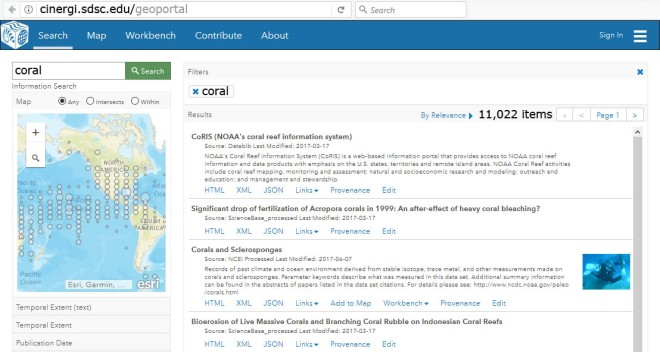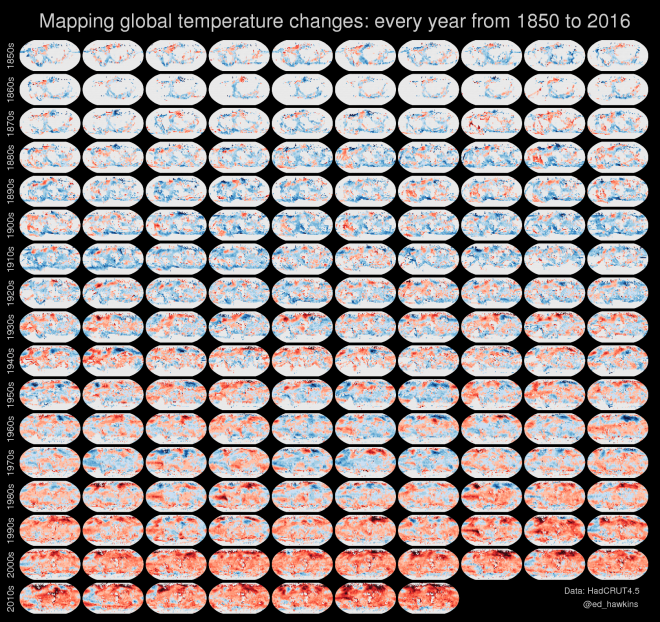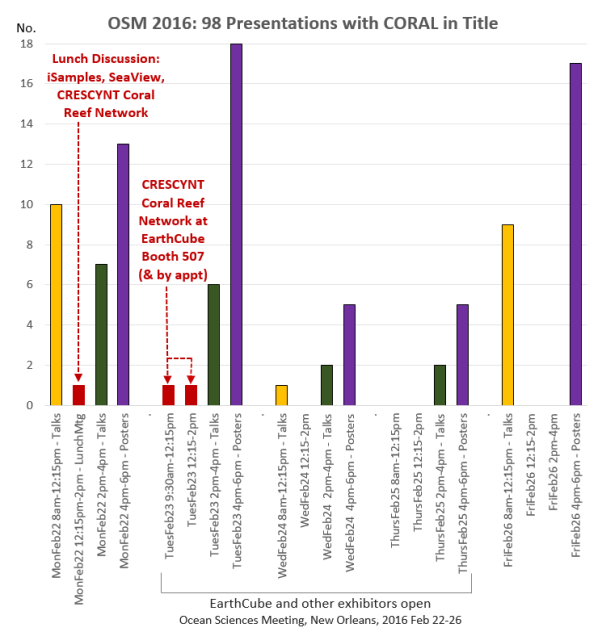Attendance is free and open to the public, online or in person.
>>>Go to the blog Masterpost or the CRESCYNT website or NSF EarthCube.<<<

Attendance is free and open to the public, online or in person.
>>>Go to the blog Masterpost or the CRESCYNT website or NSF EarthCube.<<<

Announcing recent progress for data discovery in support of coral reef research!
Take advantage of this valuable community resource: a data discovery search engine with a special nose for locating coral reef research data sources: cinergi.sdsc.edu.
A major way CRESCYNT has made progress is by serving as a collective coral reef use case for EarthCube groups that are building great new software tools. One of those is a project called CINERGI. It registers resources – especially online repositories and individual online datasets, plus documents and software tools – and then enriches the descriptors to make the resources more searchable. The datasets themselves stay in place: a record of the dataset’s location and description are registered and augmented for better find and filter. Registered datasets and other resources, of course, keep whatever access and use license their authors have given them.
CINERGI already has over a million data sources registered, and over 11,000 of these are specifically coral reef datasets and data repositories. The interface now also features a geoportal to support spatial search options.
The CINERGI search tool is now able to incorporate ANY online resources you wish, so if you don’t find your favorite resources or want to connect your own publications, data, data products, software, code, and other resources, please contribute. If it’s a coral-related resource, be sure to include the word “coral” somewhere in your title or description so it can be retrieved that way later as well. (Great retrieval starts with great metadata!)
To add new resources: Go to cinergi.sdsc.edu, and click on CONTRIBUTE. Fill in ESPECIALLY the first fields – title, description, and URL – then as much of the rest as you can.
Thanks to EarthCube, the CINERGI Data Discovery Hub, and the great crew at the San Diego Supercomputer Center and partners for making this valuable tool possible for coral reef research and other geoscience communities. Here are slides and a video to learn more.
>>>Go to NSF EarthCube or the CRESCYNT website or the blog Masterpost.<<<

Having dedicated my PhD to automating the annotation of coral reef survey images, I have seen my fair share of surveys and talked to my fair share of coral ecologists. In these conversations, I always heard the same story: collecting survey images is quick, fun and exciting. Annotating them is, on the other hand, slow, boring, and excruciating.
When I started CoralNet (coralnet.ucsd.edu) back in 2012 the main goal was to make the manual annotation work less tedious by deploying automated annotators alongside human experts. These automated annotators were trained on previously annotated data using what was then the state-of-the-art in computer vision and machine learning. Experiments indicated that around 50% of the annotation work could be done automatically without sacrificing the quality of the ecological indicators (Beijbom et al. PLoS ONE 2015).
The Alpha version of CoralNet was thus created and started gaining popularity across the community. I think this was partly due to the promise of reduced annotation burden, but also because it offered a convenient online system for keeping track of and managing the annotation work. By the time we started working on the Beta release this summer, the Alpha site had over 300,000 images with over 5 million point annotations – all provided by the global coral community.
There was, however, a second purpose of creating CoralNet Alpha. Even back in 2012 the machine learning methods of the day were data-hungry. Basically, the more data you have, the better the algorithms will perform. Therefore, the second purpose of creating CoralNet was quite simply to let the data come to me rather than me chasing people down to get my hands on their data.
At the same time the CoralNet Alpha site was starting to buckle under increased usage. Long queues started to build up in the computer vision backend as power-users such as NOAA CREP and Catlin Seaview Survey uploaded tens of thousands of images to the site for analysis assistance. Time was ripe for an update.
As it turned out the timing was fortunate. A revolution has happened in the last few years, with the development of so-called deep convolutional neural networks. These immensely powerful, and large nets are capable of learning from vast databases to achieve vastly superior performance compared to methods from the previous generation.
During my postdoc at UC Berkeley last year, I researched ways to adapt this new technology to the coral reef image annotation task in the development of CoralNet Beta. Leaning on the vast database accumulated in CoralNet Alpha, I tuned a net with 14 hidden layers and 150 million parameters to recognize over 1,000 types of coral substrates. The results, which are in preparation for publication, indicate that the annotation work can be automated to between 80% and 100% depending on the survey. Remarkably: in some situations, the classifier is more consistent with the human annotators than those annotators are with themselves. Indeed, we show that the combination of confident machine predictions with human annotations beat both the human and the machine alone!
Using funding from NOAA CREP and CRCP, I worked together with UCSD alumnus Stephen Chan to develop CoralNet Beta: a major update which includes migration of all hardware to Amazon Web Services, and a brand new, highly parallelizable, computer vision backend. Using the new computer vision backend the 350,000 images on the site were re-annotated in one week! Software updates include improved search, import, export and visualization tools.
With the new release in place we are happy to welcome new users to the site; the more data the merrier!
_____________
– Many thanks to Oscar Beijbom for this guest posting as well as significant technological contributions to the analysis and understanding of coral reefs. You can find Dr. Beijbom on GitHub, or see more of his projects and publications here. You can also find a series of video tutorials on using CoralNet (featuring the original Alpha interface) on CoralNet’s vimeo channel, and technical details about the new Beta version in the release notes.
>>>Go to NSF EarthCube or the CRESCYNT website or the blog Masterpost.<<<
Temperature is a critical environmental parameter that has profound relevance in describing where coral reefs do and do not occur, and growing direct and indirect threats to their existence.
Here are some powerful visualizations of global temperature data you may find useful or want to replicate for local or global temperature datasets, or use for education and outreach about climate change.
First, spiralling global temperatures by Ed Hawkins (using MATLAB):

The climate spirals page of Hawkins’ Climate Lab Book features global temperature change updates, as well as atmospheric CO2 and arctic sea ice volume animations. His small multiples assembly of global temperatures by decade is very useful, and could be used to describe sequential environmental changes on regional map scales as well.

Ed Hawkins also links to Robert Geiseke and Malte Meinshausen’s interactive tool and a set of video animations for offline use that build upon his work.
NASA’s temperature graphs and charts are varied and useful, and have pages for downloading different temperature products for specific date ranges, including global maps, surface temperature animations, and this 135-year time chart of zonal temperature anomalies:

See NASA’s Global Climate Change – Global Temperature site for rich multimedia resources and apps, including global temperature anomaly maps with year sliders and an embeddable 3-min video which graphs different potential factors with global temperature changes (surprise: the correlation is with anthropogenic CO2). High global temperatures and low Arctic sea ice cover both broke records in the first half of 2016.
NOAA has its own further derivations of very useful temperature representations, particularly for coral reef work, including global and regional sea surface temperature contour maps, a suite of coral bleaching data products with predictive bleaching alerts derived from virtual stations, and their degree heating weeks maps, which some NOAA scientists prefer as their most accurate post-event indicator of peak bleaching intensity.
Thanks for inspiration to Andrew Freedman’s excellent article on Mashable featuring compelling temperature visualizations.
If there’s a temperature visualization you love – including simple – simple is good – please share it with us by leaving a comment. Thanks.
Update: (1) fresh updated graphs and more at Ed Hawkins’ Climate Lab Book (or follow on Twitter: @ed_hawkins), and (2) check out Antti Lipponen’s temperature anomalies by country since 1900 – as animation or small multiples – showing variation and warming trends, with visual insight into continents.
>>>Go to the blog Masterpost or the CRESCYNT website or NSF EarthCube.<<<

Imagery REALLY feeds our monkey brains. Today: tools for 3D reef mapping. Bonus: some 360-degree images and video to use with virtual reality headsets.
Several exciting talks at the International Coral Reef Symposium featured 3D mapping of coral reefs using SfM, Structure from Motion techniques, to stitch together large numbers of overlapping images. The resulting 3D mapped images were used to help address a surprising range of research questions. The primary tools used to create these were Agisoft’s PhotoScan or the free and open source Bundler (github) by Noah Snavely. Part of the challenge of this difficult work is organizing the workflows and data processing pipelines: it’s an example of a type of cyberinfrastructure need that eventually EarthCube architecture should be able to help stage. Look for a guest blog soon by John Burns to learn more!

BONUS: The process of creating spherical or 360-degree images or video is at root a similar challenge of stitching together images, though more of the work is done inside a camera or on someone else’s platform. There are some recent beautifully-made examples of spherical coral reef images and 360 videos, viewable through virtual reality (VR) headsets; these have great potential for education and outreach. Consider the XL Catlin Seaview Survey gallery of coral reef photo spheres and videos from around the world, (including bleaching and before-and-after images) and Conservation International’s 8-minute video, Valen’s Reef, both exhibited at the current IUCN World Conservation Congress in Honolulu.

A new project, Google Expeditions, was launched this past week to facilitate synchronized use by multiple people of 360 videos and photo spheres as a design for class use. Google Streetview is being made more accessible as a venue for education and outreach, including creating and publishing one’s own photo spheres. Also find 360-videos of coral reefs on YouTube.
UPDATE: Visually powerful 360 bleaching images that Catlin Seaview debuted at ICRS, viewed by tablet or smartphone, are now accessible in this article on coral bleaching.
>>>Go to the blog Masterpost or the CRESCYNT website or NSF EarthCube.<<<
“Search One and Done”… don’t you wish there was a KAYAK search tool for datasets?
Currently, the closest thing to a single search interface that pulls from a broad collection of heterogeneous data repositories at diverse scales is DataONE (http://dataone.org). Available DataONE repositories (“member nodes”) that host a substantial number of datasets about and relevant to coral reef work include:
You can get your own data into DataONE through KNB or ONEShare member nodes if other repositories are not a good fit.
DataONE continues to be actively developed and improved, and to add new member nodes. It currently provides access to over 630,000 metadata and datasets. Don’t miss DataONE’s Investigator Toolkit (https://www.dataone.org/investigator-toolkit).
 Please check it out and let us know what you think!
Please check it out and let us know what you think!
>>>Go to the blog Masterpost or the CRESCYNT website or NSF EarthCube.<<<
If the only tool you have is a hammer, everything looks like a nail.

Our new Toolbox series for the coral reef community will highlight one tool each week relevant to data management, analysis, visualization, storage, retrieval, reuse, or collaboration. We’ll try to focus on the most comprehensive, useful, and relevant tools for coral reef work.
We hope you’ll take time to try each one out, and then tell us what you think.
~~~~~~~~~~~~~~~~~~
This week: Biodiversity information aggregated at GBIF (http://gbif.org ).
The Global Biodiversity Information Facility (GBIF) pulls together species and taxonomic entries from over 800 authoritative data publishers and constantly updates them. GBIF intake includes favorite coral reef species databases (WoRMS, iDigBio, ITIS, Paleobiology,…). Bonus: GBIF makes it easier to search NCBI to find ‘omics data on corals, symbionts, and holobionts.
Search by taxon, common name, dataset, or country; apply filters, and link directly to providers’ websites. Explore species now at http://gbif.org/species .
Yours for a more robust toolbox.
>>>Go to the blog Masterpost or the CRESCYNT website or NSF EarthCube.<<<
CRESCYNT IS AT #ICRS2016 – International Coral Reef Symposium in Honolulu, Hawaii!
EVENTS:
WORKSHOP – Cyber Tools and Resources for Coral Reef Research and Analysis
Sun. June 19 8:30am-4:00pm, Hawaii Convention Center rm 314
(breakfast, lunch provided – register here)
ask about materials / future webinars if you miss
sponsored by EarthCube CRESCYNT – some seats still open!
CRESCYNT Node Coordinators Meeting
Mon June 20 6:00-8:30pm, Hawaii Convention Center 307 A/B
OPEN MEETING – CRESCYNT Participants with Node Coordinators
Wed June 22, 11:30am-12:45pm, Hawaii Convention Center 307A/B
(bring your ICRS lunch – we’ll have ice cream)
OPEN TO ALL – come if you’re interested!
DISCUSSION & SYNTHESIS SESSION: Emerging Technologies for Reef Science and Conservation
Fri June 24, 9:30am-3:45pm, Hawaii Convention Center 312
(Discussion 11-11:30am. CRESCYNT at 2pm)
UPDATE: Find all the meeting abstracts in this 414-page pdf book
>>>Go to the blog Masterpost or the CRESCYNT website or NSF EarthCube.<<<
The 2016 Ocean Sciences Meeting is coming up in New Orleans 21-26 February 2016, and we hope to see you there! There are 97 oral and poster session presentations scheduled with CORAL in the title (plus a lunchtime presentation from CRESCYNT, making 98), and we hope to talk with coral reef researchers about YOUR needs and priorities for data, analysis, and cyberinfrastructure.
1 – Joint lunchtime discussion held with iSamples, CRESCYNT, and SeaView on Monday, Feb. 22, 12:30-2:00pm. Lunch will be provided! Register at http://bit.ly/1QFHLd1.
2 – CRESCYNT coral reef RCN will be at the EarthCube exhibitor booth 507 periodically, including Tuesday, Feb. 23, 9:30am – 2:00pm and on other days by appointment. Come by at that time or any time to fill out a CRESCYNT priority survey and learn more about EarthCube.
3 – Please email us at crescyntrcn@gmail.com to set something up. We’d love to talk with you while at OSM (or any other time).
The chart below shows when the coral-related oral papers and poster sessions will take place. Hope to see you there!

>>>Go to the blog Masterpost or the CRESCYNT website or NSF EarthCube.<<<